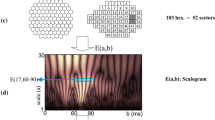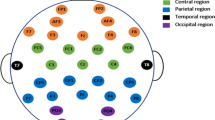Abstract
The processing of biosignals is increasingly being utilized in ambulatory situations in order to extract significant signals’ features that can help in clinical diagnosis. However, this task is hampered by the fact that biomedical signals exhibit a complex behavior characterized by strong nonlinear and non-stationary properties that cannot always be perceived by simple visual examination. New processing methods need be considered. In this context, we propose a signal processing method, based on empirical mode decomposition and artificial neural networks, to analyze electroretinograms, i.e., the retinal response to a light flash, with the aim to detect and classify retinal diseases. The present application focuses on two retinal pathologies: achromatopsia, which is a cone disease, and congenital stationary night blindness, which affects the photoreceptoral signal transmission. The results indicate that, under suitable conditions, the method proposed here has the potential to provide a powerful tool for routine clinical examinations, since it is able to recognize with high level of confidence the eventual presence of one of the two pathologies.








Similar content being viewed by others
References
Abdullayev NT, Ismaylova K (2012) Use of neural networks for recognition of pathological changes in stimulative electromyograms. Biomed Eng 45(6):201–206
Abu Anas EM, Lee SY, Hasan Md K (2011) “Exploiting correlation of ECG with certain EMD functions for discrimination of ventricular fibrillation. Comput Biol Med 41:110–114
Agrafioti F, Hatzinakos D, Anderson AK (2012) ECG pattern analysis for emotion detection. IEEE Trans Affect Comput 3(1):102–115
Ai L, Wang J, Yao R (2011) Classification of Parkinsonian and essential tremor using empirical mode decomposition and support vector machine. Digit Signal Process 21:543–550
Atoui H, Fayn J, Rubel P (2010) A novel neural-network model for deriving standard 12-lead ECGs from serial three-lead ECGs: application to self-care. IEEE Trans Inf Technol B 14(3):883–890
Bagheri A, Li K, Rizzo P (2013) Reference-free damage detection by means of wavelet transform and empirical mode decomposition applied to Lamb waves. J Intell Mater Syst Struct 24(2):194–208
Barni M, Failla P, Lazzeretti R, Sadeghi A, Schneider T (2011) Privacy-preserving ECG classification with branching programs and neural networks. IEEE Trans Inf Forensic Secur 6(2):452–467
Barraco R, Persano Adorno D, Bellomonte L, Brai M (2009) A study of the human rod and cone electroretinogram a-wave component. J Stat Mech Theor Exp 3:P03007
Barraco R, Persano Adorno D, Brai M (2011) ERG signal analysis using wavelet transform. Theor Biosci 130(3):155–163. doi:10.1007/s12064-011-0124-1
Barraco R, Persano Adorno D, Brai M (2011) An approach based on wavelet analysis for feature extraction in the a-wave of the electroretinogram. Comput Methods Prog Biol 104:316–324. doi:10.1016/j.cmpb.2011.05.001
Barraco R, Persano Adorno D, Brai M, Tranchina L (2014) A comparison among different techniques for human ERG signals processing and classification. Phys Med 30:86–95. doi:10.1016/j.ejmp.2013.03.006
Bas B, Ozgonenel O, Ozden B, Bekcioglu B, Bulut E, Kurt M (2012) Use of artificial neural network in differentiation of subgroups of temporomandibular internal derangements: a preliminary study. J Oral Maxillofac Surg 70:51–59
Birch DG, Hood DC, Locke KG, Hoffman DR, Tzekov RT (2002) Quantitative electroretinogram measures of phototransduction in cone and rod photoreceptors: normal aging, progression with disease, and test-retest variability. Arch Ophthalmol 120(8):1045–1051
Boquete L, Miguel-Jiménez JM, Ortega S, Rodríguez-Ascariz JM, Pérez-Rico C, Blanco R (2012) Multifocal electroretinogram diagnosis of glaucoma applying neural networks and structural pattern analysis. Expert Syst Appl 39:234–238
Burns JW, Consens FB, Little RJ, Angell KJ, Gilman S, Chervin RD (2007) EMG variance during Polysomnography as an assessment for REM sleep behaviour disorder. Sleep 30(12):1771–1778
Ceylan R, Ceylan M, Özbay Y, Kara S (2011) Fuzzy clustering complex-valued neural network to diagnose cirrhosis disease. Expert Syst Appl 38:9744–9751
Fulton AB, Hansen RM, Westall CA (2003) Development of ERG responses: the ISCEV rod, maximal and cone responses in normal subjects. Doc Ophthalmol 107(3):235–241
Hagan MT, Menhaj M (1994) Training feed-forward networks with the Marquardt algorithm. IEEE Trans Neural Netw 5(6):989–993
Haseena HH, Mathew AT, Paul JK (2011) Fuzzy clustered probabilistic and multi layered feed forward neural networks for electrocardiogram arrhythmia classification. J Med Syst 35:179–188
Hood DC, Birch DG (1990) A quantitative measure of the electrical activity of human rod photoreceptors using electroretinography. Vis Neurosci 5:379–387
Hsu WY (2012) Fuzzy Hopfield neural network clustering for single-trial motor imagery EEG classification. Expert Syst Appl 39:1055–1061
Huang NE, Shen Z, Long SR, Wu MC, Shih HH, Zheng Q, Yen NC, Tung CC, Liu HH (1998) The empirical mode decomposition and the Hilbert spectrum for nonlinear and non-stationary time series analysis. Proc R Soc Lond A 454:903–995
Janušauskas A, Marozas V, Lukoševičius A (2012) Ensemble empirical mode decomposition based feature enhancement of cardio signals. Med Eng Phys 35:1059
Karagiannis A, Constantinou P (2011) Noise-assisted data processing with empirical mode decomposition in biomedical signals. IEEE T Inf Technol B 15(1):11–18
Krupa N, Ali M, Zahedi E, Ahmed S, Hassan FM (2011) Antepartum fetal heart rate feature extraction and classification using empirical mode decomposition and support vector machine. BioMed Eng OnLine 10:6
Lee J, McManus DD, Merchant S, Chon KH (2012) Automatic motion and noise artifact detection in holter ECG data using empirical mode decomposition and statistical approaches. IEEE Trans Bio Med Eng 59(6):1499–1506
Liu S, Gao RX, John D, Staudenmayer J, Freedson P (2013) Tissue artifact removal from respiratory signals based on empirical mode decomposition. Ann Biomed Eng. doi:10.1007/s10439-013-0742-5
Marmor MF, Arden GB, Nilsson SEG, Zrenner E (1989) International standardisation committee, standard for clinical electroretinography. Arch Ophthalmol 107:816–819
Marmor F, Holder GE, Seeliger MW, Yamamoto S (2004) Standard for clinical electroretinography (2004 update). Doc Ophthalmol 108:107–114
Md A, Kabir C Shahnaz (2012) Denoising of ECG signals based on noise reduction algorithms in EMD and wavelet domains. Biomed Signal Process 7(5):481–489
Miguel-Jimenez JM, Ortega S, Boquete L, Rodriguez-Ascariz JM, Blanco R (2011) Multifocal ERG wavelet packet decomposition applied to glaucoma diagnosis. BioMed Eng OnLine 10(1):37
Morillo DS, Gross N (2012) Probabilistic neural network approach for the detection of SAHS from overnight pulse oximetry. Med Biol Eng Comput. doi:10.1007/s11517-012-0995-4
Oweis RJ, Abdulhay EW (2011) Seizure classification in EEG signals utilizing Hilbert–Huang transform. BioMed Eng OnLine 10:38
Pachori RB, Bajaj V (2011) Analysis of normal and epileptic seizure EEG signals using empirical mode decomposition. Comput Methods Prog Biol 104:373–381
Pal S, Mitra M (2010) Detection of ECG characteristic points using multiresolution wavelet analysis based selective coefficient method. Measurement 43:255–261
Pal S, Mitra M (2012) Empirical mode decomposition based ECG enhancement and QRS detection. Comput Biol Med 42:83–92
Petrėnas A, Marozas V, Sörnmo L, Lukoševičius A (2012) An echo state neural network for QRST cancellation during atrial fibrillation. IEEE Trans Bio Med Eng 59(10):2950–2957
Pinheiro E, Postolache O, Girão P (2012) Empirical mode decomposition and principal component analysis implementation in processing non-invasive cardiovascular signals. Measurement 45(2):175–181
Rizzo P, Lanza di Scalea F (2006) Wavelet-based feature extraction for automatic defect classification in strands by ultrasonic structural monitoring. Smart Struct Syst 2(3):253–274
Rizzo P, Lanza F, di Scalea F (2007) Wavelet-based unsupervised and supervised learning algorithms for ultrasonic structural monitoring of waveguides, ch 8. In: Reece Peter L (ed) Progress in Smart Materials and Structures Research. NOVA publishers, New York, pp 227–290
Roman AJ, Schwartz S, Aleman TS, Cideciyan AV, Chico JD, Windsor EAM, Gardner LM, Ying G, Smilko EE, Maguire MG, Jacobson SG (2005) Quantifying rod photoreceptor-mediated vision in retinal degenerations: dark-adapted thresholds as outcome measures. Exp Eye Res 80:259–272
Sandmeyer LS, Grahn BH, Breaux CB (2006) Diagnostic ophthalmology. Can Vet J 47:1131–1133
Sidorova MA, Serzhantova NA, Filippova LA (2011) Diagnosis and prognosis of peritonitis outcome using a neural network system for hemostasis parameter examination. Biomed Eng 45(2):72–75
Srhoj-Egekher V, Cifrek M, Medved V (2011) The application of Hilbert-Huang transform in the analysis of muscle fatigue during cyclic dynamic contractions. Med Biol Eng Comput 49:659–669
Tsai PH, Lin C, Tsao J, Lin PF, Wang PC, Huang NE, Lo MT (2012) Empirical mode decomposition based detrended sample entropy in electroencephalography for Alzheimer’s disease. J Neurosci Methods 210:230–237
Tseng YL, Ko PY, Jaw FS (2012) Detection of the third and fourth heart sounds using Hilbert–Huang transform. BioMed. Eng OnLine 11:8
Uğuz H (2012) A biomedical system based on artificial neural network and principal component analysis for diagnosis of the heart valve diseases. J Med Syst 36:61–72
Usui T, Tanimoto N, Ueki S, Takagi M, Hasegawa S, Abe H, Sekiya K, Nakazawa M (2004) ERG rod a-wave in Oguchi disease. Vis Res 44(5):535–540
Ye-Lin Y, Garcia-Casado J, Prats-Boluda G, Martinez-de-Juan JL (2010) Combined method for reduction of high frequency interferences in surface electroenterogram (EEnG). Ann Biomed Eng 38(7):2358–2370
Yinhong Z, Quanlu L, Jing W (2012) The study of time-frequency analysis the nocturnal snoring signal based on the wavelet transform. J Acoust Soc Am 131(4):3443
Yuan Q, Zhou W, Zhang J, Li S, Cai D, Zeng Y (2012) EEG classification approach based on the extreme learning machine and wavelet transform. Clin EEG Neurosci 43(2):127–132
Zhang X, Zhou P (2012) Filtering of surface EMG using ensemble empirical mode decomposition. Med Eng Phys 35:537–542
Acknowledgments
The signal processing utilized in this study was developed as part of a U.S. National Science Foundation grant, award number CMMI 1029457.
Author information
Authors and Affiliations
Corresponding author
Rights and permissions
About this article
Cite this article
Bagheri, A., Persano Adorno, D., Rizzo, P. et al. Empirical mode decomposition and neural network for the classification of electroretinographic data. Med Biol Eng Comput 52, 619–628 (2014). https://doi.org/10.1007/s11517-014-1164-8
Received:
Accepted:
Published:
Issue Date:
DOI: https://doi.org/10.1007/s11517-014-1164-8




